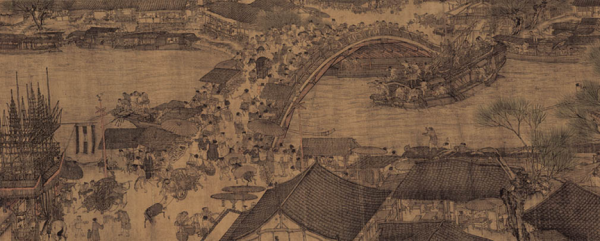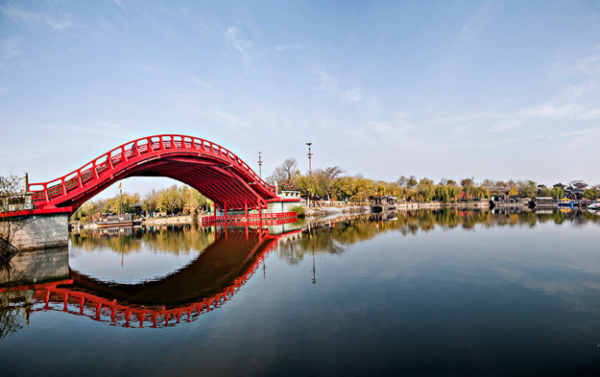by Maggie Xiaoge Li, University of Southampton
Along the River During the Qingming Festival, also known as the Qingming Shange Tu, is a Chinese painting by Song dynasty artist Zhang Zeduan (1085-1145). The scroll is 24.8 cm in height and 528 cm long. It is an historically important artwork that captures the daily life of people and the landscape of the capital Bianjing (present-day Kaifeng) during the Northern Song period (960-1127). In the passing of time, the place in the painting has been transformed by modern buildings. This scroll has thus become an important reference for restoring the historical landscape of the Song Dynasty, and the Rainbow Bridge (Hong Qiao) is one of the most well-known scenes in this painting (see Figure1). (1) As an ‘invented tradition’ the Rainbow Bridge has been reproduced many times and has become representative of daily life in the Song dynasty. To give an example, Millennium City Park is a large-scale Song Dynasty historical and cultural theme park based on imagery in the scroll. The park not only imitates famous buildings from the painting, but staff customs and various performances in the park precisely reproduce scenes in the painting (see Figure 2). Millennium City Park officially opened to the public in 1998 and promoted itself with the slogan ‘once walking into the scroll, dreaming back to the millennium in a day’. (2) In a sense, the theme park is a concrete representation of the nostalgic ‘past’ made by modern dreams.

Figure 1: Rainbow Bridge

Figure 2: Rainbow Bridge in Millennium City Park
For Svetlana Boym the two kinds of nostalgia ‘are not absolute types, but rather tendencies, ways of giving shape and meaning to longing.’ (3) As she states: ‘Restorative nostalgia puts emphasis on nostos and proposes to rebuild the lost home and patch up the memory gaps. Reflective nostalgia dwells in algia, in longing and loss, the imperfect process of remembrance.’ (4) In contrast to visiting the park as a tourist, the gaming experience of the Song landscape seems more related to the player’s immersion in nostalgic dreams. For example, Ni Shui Han (NetEase, 2018) is a wuxia MMORPG (Massively Multiplayer Online Role-Playing Game) on the PC platform. The game is set in the Northern Song Dynasty, with the modeling of the game scene heavily drawing on recognisable imagery of the Northern Song Dynasty. (5) The Rainbow Bridge is an important scene in the game that directly transforms the painting Along the River During the Qingming Festival from a static to a dynamic aesthetic experience. In this game scene, people, horses are all in action, the vendors on the bridge even wave their hands to solicit business.
As Boym notes, ‘Creative nostalgia reveals the fantasies of the age, and it is in those fantasies and potentialities that the future is born. One is nostalgic not for the past the way it was, but for the past the way it could have been.’ (6) The virtual reality in the game no longer focuses on how to restore ‘reality’ - the game world looks more ‘realistic’ than ‘reality’. With the support of technology, the virtual gaming experience goes far beyond visiting a theme park. A useful parallel to draw might be Baudrillard’s notion of ‘hyperreality’ - a concept best understood as ‘the inability of consciousness to distinguish reality from a simulation of reality. It describes how the line between real and fake is blurred, particularly in postmodern societies where technology is highly advanced.’ (7) The various types of multimedia that can radically alter or fabricate an original event or experience and therefore what our mind defines as ‘real’ in this world can be ‘hyperreal’. (8) Describing the ‘hyperreal’ in his Simulacra and Simulation Baudrillard talks of a ‘generation by models of a real without origin or reality.’ (9) Digital games build a world which is meant to appear ‘real’ and increase a sense of presence even while the real Rainbow Bridge does not exist in reality.

Figure 3: Rainbow Bridge in Game Ni Shui Han
As a new media, digital games not only restore a ‘past’ that no longer exists or never existed like the nostalgia film, but also draw the player in the nostalgic ‘past’ by playing a character situated in this world. This feeling itself would be difficult to ‘duplicate’ in non-virtual environments such as theme parks in a sustained manner. As Erik Champion points out, virtual travel in cyberspace offers a truly immersive experience:
Virtual travel has the potential to provide an ‘immersive’ place-experience, the full and dramatic range of climate and topography (that is, experiences not usually accessible to short-term visitors). There are also opportunities to experience at first-hand important historical events which requires the meaningful integration of artifacts, people and place. (10)
Virtual travel in digital games is more akin to being given a new identity as a local resident who lives in this environment rather than a tourist who only comes to occasionally enjoy the ‘scenery‘. The relationship between the player and the game environment becomes closer through ‘role-playing’, with the player’s character designed as integral to the fictional time and space. For example, when a NPC (Non-Player Character) interacts with the player’s character, the player might notice that some NPCs have known the player’s character for a long time, offering greetings like ‘Hello, long time no see. How are you?’, even if this is the first time the player saw this NPC. At the same time, the player will respond accordingly as a real ‘resident’ who lives in this world and gradually develops a sense of familiarity with NPCs.
When players engage with the fictional world through their avatars, the ‘past’ might be fabricated, but the ‘longing’ is real. Reflective nostalgia, or the ‘longing’ for this virtual world, is often intrinsic to the gaming experience. Studying nostalgia gives us insight not only into what specific aspects of history are being remembered and why, but also into how a culture communicates among its members. The details in the game not only to fill the memory gaps of the ‘past’, but more importantly, provides each player with an experiential engagement with the ‘past’, of becoming confronted with another reality.
Footnotes
(1) Image from: The Palace Museum <https://www.dpm.org.cn/collection/paint/228226.html> [accessed 2 May 2021]
(2) Official website of Millennium City Park,<http://www.qingmings.com> [accessed 2 May 2021]
(3) Svetlana Boym, The Future of Nostalgia (New York: Basic Books, 2001), p. 41.
(4) Ibid.
(5) Image from Ni Shui Han game official website.
(6) Svetlana Boym, The Future of Nostalgia (New York: Basic Books, 2001), p. 351.
(7) See the concept of hyperreality from <http://enterhyperreality.weebly.com>[accessed 20 May 2021]
(8) Ibid.
(9) Jean Baudrillard, Simulacra and Simulation (Ann Arbor, MI: The University of Michigan Press, 1994), p. 1.
(10) Erik Champion, Playing with the Past (London: Springer, 2011), p. 8.